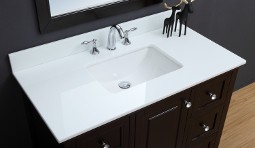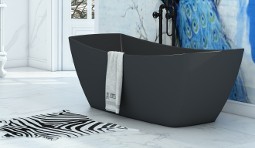
Learn how to get — and keep — your bathtub sparkling clean
Cleaning the bathtub. It’s a chore that looms large, usually because in any bathroom, the tub itself looms large. It also seems to require a lot of scrubbing and leaning over and generally contorting yourself into a few strange positions. While cleaning the bathtub will never be totally painless, there are some tricks you can use to make it easier to clean and to keep it shiny for much longer.
Before you start to clean, you need to know what type of finish your tub has. Most tub finishes are porcelain, enamel, acrylic or fiberglass. If the finish looks like plastic, it’s one of the latter two. If your tub is made from a more unusual material, such as stone or copper, check with your tub’s manufacturer for cleaning instructions.
1. Cleanser Choices
There are a lot of cleansers on the market along with popular homemade solutions. A paste made by combining equal parts baking soda and water is fine for any type of tub and works especially well on soap scum.
Beyond that, the tub’s finish makes a difference in what you use. You have more options for a porcelain finish, which is by far the toughest surface, including a vinegar-based solution. “We try to use as few nasty chemical products as possible,” says Lynn Blair-Broeker, one of the owners of What Needs Done, a chore service company in Cedar Falls, Iowa. “A mixture of warm vinegar and a bit of Dawn and a scrub pad does a pretty good job on tub soap scum. I also find microfiber rags and water work on a tub that is not too scummy.”
If you opt for a commercial cleanser, your first step is to read the label carefully, according to Gary Uhl, brand education director at American Standard, as even some seemingly gentle lotion-like cleansers can be abrasive. For porcelain and enamel finishes, a cleanser that includes a mildly abrasive component is fine. Acrylic tubs scratch easily; you should only use something that is completely nonabrasive on them.
2. Stain Treatments
Acrylic.
Here’s where acrylic finishes come out ahead, as the finish itself repels stains. If you do have a stain on an acrylic or a fiberglass surface, treat it with ½ to ⅔ cup of clear dishwashing liquid mixed with 2 cups of hot water. If that isn’t strong enough, try a paste of cream of tartar and hydrogen peroxide or baking soda and water, but test in a low-visibility area first. There are also those who swear by using an inexpensive plain white toothpaste (no brightening agents or added features) on stains.
Enamel.
Enamel finishes are also more delicate, and bleach will stain them. Instead, try the same solutions as for an acrylic finish, mentioned above.
Porcelain.
For porcelain tubs, bleach has been a go-to stain remover for years, but eventually it can wear down the finish. Instead, start with a baking soda and water solution. A dishwashing liquid solution works well for soap scum. If the stain is caused by hard water, mix vinegar and water and spray it on the stain. For rust stains, you may need to use a commercial rust remover.
If none of these work on a porcelain finish, the next step would be a pumice stone, Magic Eraser or commercial stain remover. Start with the least abrasive options to save wear and tear on the finishes. And some stains, especially on older tubs whose finish has become worn or damaged, may never come out. In that case, reglazing may be an option.
Caution
Never mix bleach and ammonia.
3. Tub Cleaning Techniques
Once you’ve decided on a cleanser, it’s time to face the tub. Start by clearing everything off the edges so you have a clean slate.
Next, treat any stains. Then apply your chosen cleanser, spreading the paste in a circular motion or spraying the cleanser on the entire surface, starting from the rim of the tub, working along the sides and finishing at the bottom.
The next step is easy. According to Meg Roberts, president of Molly Maid, most people make the mistake of applying the cleanser and any stain treatment and then cleaning immediately, rather than giving them time to work. “We put too much elbow grease into it,” she says, noting that Molly Maid employees spray the wet surfaces, such as the tub and sink, then turn to cleaning the dry surfaces in the room. It may be half an hour before they return to cleaning the tub. You can follow that schedule or follow Roberts’ suggestion and spend the next hour playing with the dog, taking a walk or simply relaxing.
Once the cleanser has had time to work, scrub the sides and bottom of the tub, starting from the top and working your way down. For the least abrasive approach, choose a soft cloth or microfiber cloth. Other options include a soft-bristled scrub brush or one of the longer-handled shower and tub scrubbers that are designed to save you some back strain.
If you have an acrylic tub, use a cloth or scrubber that’s made from nylon, which won’t scratch the surface. “Researchers have found that even paper towels can scratch a plastic finish,” Uhl says. An old toothbrush is handy for cleaning around drains and other tight surfaces.
The next step is to rinse the tub thoroughly, either by spraying with the shower nozzle or rinsing with a bucket of clean water. This practice is often overlooked but essential, according to Uhl. He notes that while leaving a cleanser on for an hour is fine, leaving it on for a week can permanently harm the tub’s finish. He also suggests cleaning shower doors to remove any overspray from the cleanser.
Finally, dry the tub thoroughly with a soft cloth (microfiber works very well) so it shines. Roberts says this step doesn’t take long and is key for a polished look.
4. Preventive Practices
Perhaps the most important step in having a clean tub is what you do after you’ve cleaned to minimize future problems, especially the ever-present soap scum. All the experts agree that wiping down the tub and drying after each use go a long way towards keeping it looking good — and keeping your cleaning time to a minimum. Blair-Broeker has another suggestion that’s easy to implement. “Once clean,” she says, “we suggest to homeowners that they switch to a bath gel. It is the talc in bar soap that creates the scum. If they feel they don’t want to make that switch, we encourage using a hard soap.”
Source:https://www.houzz.com/ideabooks/57509172/list/4-secrets-to-a-shiny-clean-bathtub



































